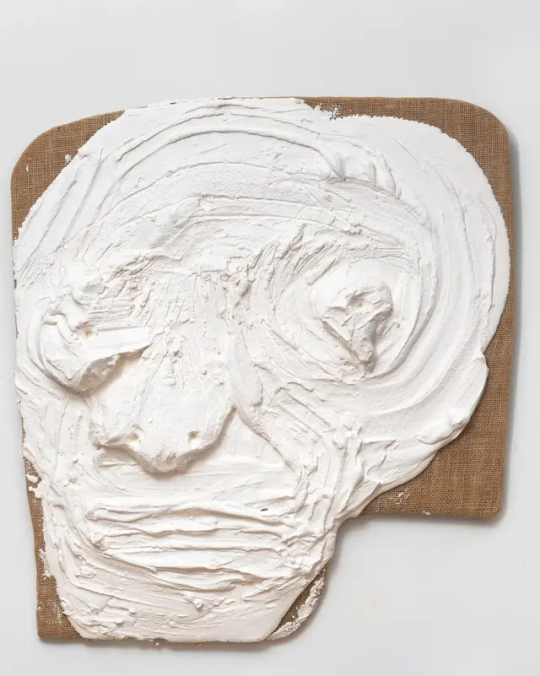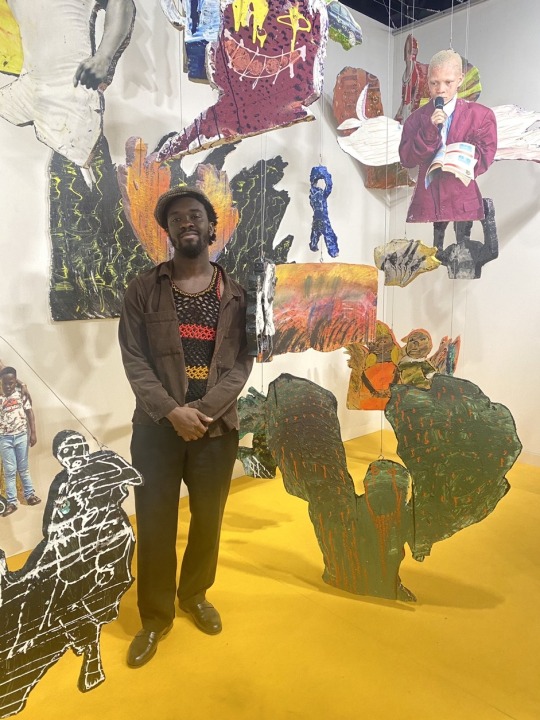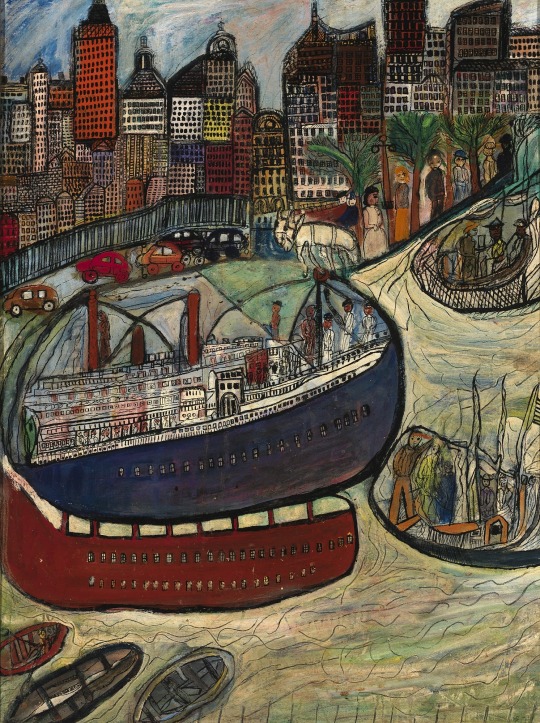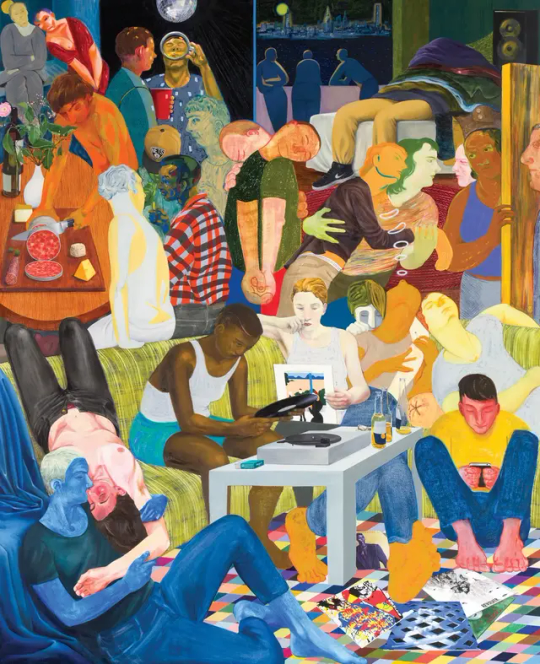#anton kern
Explore tagged Tumblr posts
Text

Nobuyoshi Araki, “Untitled [92/9/21]” (1993),
From the series 101 Works for Robert Frank (Private Diary) (1992–2005).
© Nobuyoshi Araki, courtesy Anton Kern Gallery, New York
#art#photography#fierce#black and white#nobuyoshi araki#robert frank#diary#asleep#sleeping beauty#eroticism#minimal#japan#anton kern
5 notes
·
View notes
Text

Aaron High Priest of the Israelites
Artist: Anton Kern (German, 1710–1747)
Date: 18th century
Medium: Oil on canvas
Collection: Private Collection
Description
The Bible relates that, unlike Moses, who grew up in the Egyptian royal court, Aaron and his elder sister Miriam remained with their kinsmen in the northeastern region of the Nile Delta.
According to the Book of Exodus, Aaron first functioned as Moses' assistant. Because Moses complained that he could not speak well, God appointed Aaron as Moses' "prophet" (Exodus 4:10-17; 7:1) At the command of Moses, he let his rod turn into a snake. Then he stretched out his rod in order to bring on the first three plagues. After that, Moses tended to act and speak for himself.
During the journey in the wilderness, Aaron was not always prominent or active. At the battle with Amalek, he was chosen with Hur to support the hand of Moses that held the "rod of God". When the revelation was given to Moses at Mount Sinai, he headed the elders of Israel who accompanied Moses on the way to the summit. While Joshua went with Moses to the top, however, Aaron and Hur remained below to look after the people. From here on in Exodus, Leviticus and Numbers, Joshua appears in the role of Moses' assistant while Aaron functions instead as the first high priest.
According to the Book of Numbers, Aaron died at 123 years of age, on Mount Hor, in the fortieth year after the Israelites had come out of the land of Egypt. Deuteronomy, however, places these events at Moseroth.
#aaron#high priest#levites#christian art#christian faith#book of exodus#anton kern#german painter#oil on canvas#biblical art#artwork#christianity#fine art#oil painting#costume#bell#column#embroidery#white beard#head piece#art and the bible#painting#german culture#german art#european art#18th century painting
6 notes
·
View notes
Text

It's January 2025 and Nicole Eisenman has a newly opened show at Anton Kern in NYC called Plastered that includes some of her earliest sculptural works, tasty facelike plaster-on burlap objects called Understudies.
image: Nicole Eisenman, Understudies, 2012, via antonkerngallery
6 notes
·
View notes
Text

Nicole Eisenman The General, 2018 Bronze, polished stainless steel, paint, cloth 30 x 33 x 19 inches (76 x 84 x 48 cm)
Anton Kern Gallery
98 notes
·
View notes
Text

MAN OF PEACE
Moses is true and his Torah is true. (Talmud, Bava Batra 74a) Be of the disciples of Aaron; one who loves peace, pursues peace, loves God’s creatures and draws them close to Torah. (Ethics of the Fathers 1:12) Moses was the greatest prophet in Jewish history. He brought the Jews out of Egypt, received the Torah at Mt. Sinai, and led his people in the wilderness for 40 years. Yet the Lubavitcher Rebbe reminds us that another great man was always at Moses’ side: his older brother Aaron, an individual of unparalleled benevolence who didn’t resent Moses for his privileged upbringing in the palace or status as God’s chosen messenger. Leading the Jewish people was a team effort. Moses and Aaron’s roles were different yet complementary, as we see in this week’s parsha, Tetzaveh. Moses is responsible for bringing oil to light the ever-burning menorah in the Mishkan (Tabernacle), while Aaron is in charge of actually lighting the menorah. Both Moses and Aaron’s unique gifts were required to turn a notoriously stiff-necked people into God’s representatives on earth and a light unto the nations. The Midrash characterizes each man’s personal characteristics by referring to a verse from Psalms, “Benevolence and truth are met together; righteousness and peace have kissed.” (Ps. 85:11) Aaron represents benevolence and peace, while Moses represents truth and righteousness. Righteous Moses brought the truth from Mount Sinai; benevolent Aaron helped the people live peacefully by that truth. Moses brings the oil, Aaron lights it.
Image: “Aaron, High Priest of the Israelites” by Anton Kern, 1747 (detail)
Dedicated by Steve Potter
12 notes
·
View notes
Text

In front of my recent installation @ Art Basel this year at Anton Kern Gallery’s booth.
Photo credit Joshua obel
56 notes
·
View notes
Text

Esther Hamerman, Untitled (East River), after 1950, oil on canvas, 231⁄4 x 175⁄16 in. (59.1 x 44.0 cm.), Smithsonian American Art Museum, Gift of David L. Davies, 1992.37.8 Esther Hamerman (born Esther Wachsmann; 1886–1977) was a Polish-born American painter. Hamerman, who was self-taught, has been described as a "leading practitioner" of memory painting. She is considered a folk artist. Born: Sep 21, 1886 Wieliczka, Poland Died: 1977 (aged 90–91) New York City, New York, U.S. Her great-granddaughter is Nicole Eisenman Nicole Eisenman (born 1965) is a French-born American artist known for her oil paintings and sculptures. (her great-grandmother was Esther Hamerman, a Polish-born painter.) via Wikipedia

“Another Green World,” from 2015, shows people at a houseparty, painted at various levels of verisimilitude.Art work courtesy the artist and Anton Kern Gallery / Collection of the Museum of Contemporary Art
#Esther Hamerman#polish folk#polish woman artist#Nicole Eisenman#art by women#art#palianshow#women's art#art herstory
9 notes
·
View notes
Text

kai althoff anton kern gallery 1997 Hilfen und Recht der äußeren Wand (an mich)
2 notes
·
View notes
Text

Artists included: Ángel Zárraga, Marten de Vos, Artus Wolfaerts, Jacopo Zanguidi, Jacob de Backer, Gerrit van Honthorst, Francesco Guarino da Solofra, Francesco Guarino, The Master of the Parrot, Antwerp School, Manuel Lopez Vazquez, Anton Kern, Pere Lembrí, Valencian School, Caravaggio, Anton Raphael Mengs, School of Toledo, Spanish School, Pedro Orrente, Francisco Camilo, Bolognese School, Northern follower of Leonardo da Vinci, Ferrarese School, Jacopo Bassano, Marco Palmezzano, Marco Palmezzano, Orazio Lomi Gentileschi, Giovanni Battista Piazzetta, Jacques Stella, Artemisia Gentileschi, Daniele Crespi, Onorio Marinari, Gregorio Lazzarini, Francesco de Mura, Francisco Camilo, Sir Peter Paul Rubens, Theodoor Rombouts, Jacques d'Arthois…
Please follow link for full post
Francesco Guarino da Solofra,Artus Wolfaerts,Jacob de Backer,Gerrit van Honthorst,Jacopo Zanguidi,Marten de Vos,RELIGIOUSART, Zaidan, Mythology, Religion, biography, Paintings, Art, History, Ancient, footnotes,
66 Paintings - RELIGIOUS ART BY THE OLD MASTER PAINTERS - Paintings from the Bible, with footnotes
#Icon#Bible#biography#History#Jesus#mythology#Paintings#religionart#Saints#Zaidan#footnote#fineart#Calvary#Christ
2 notes
·
View notes
Text
Say It in Wood: Typography Signs That Speak Volumes

Ready to take your typographic talents from paper to planks? Today’s all about crafting wooden signs that say exactly what you want—in your style, your font, your voice. Whether it’s a farmhouse-chic “Welcome” by the door or a quirky “No Wi-Fi. Pretend it’s 1993” for your living room, typography on wood brings character and charm that lasts.
This is where your words become part of the furniture—literally.
🌲 Why Wood?
Wood is durable, rustic, and timeless. It can be sanded, stained, painted, burned, or carved—making it one of the most versatile typography-friendly surfaces. You’re not just writing words, you’re building heirlooms.
��️ Materials You’ll Need:
Wood (pine, plywood, reclaimed wood, etc.)
Sandpaper (optional but recommended)
Acrylic paint or wood stain
Vinyl stencils OR printable design + graphite paper
Paintbrushes or paint pens
Clear sealer (like Mod Podge or polyurethane)
Optional: wood burner or Dremel for carving
🔠 Typography Tips for Wooden Signs:
Bold fonts show up better from afar. Think Bebas Neue, Impact, or League Gothic.
Script fonts like Great Vibes or Sacramento work well for names or short phrases but avoid overusing them—they can be hard to read.
Mix fonts—pairing script with sans-serif can make your signs look pro.
Adjust kerning and line spacing so your design breathes and doesn’t look cramped.
✍️ Techniques for Getting Your Typography on Wood:
1. Paint + Stencil Method (Beginner-Friendly)
Sand & Prep the Wood Smooth the surface and optionally apply a base coat or wood stain.
Apply Vinyl Stencil or Printed Transfer Use transfer paper or graphite paper to trace a printed design onto the wood.
Paint Your Letters Use acrylic paint and a small brush for precision. Remove stencils carefully.
Seal It Once dry, apply a sealer to protect it.
2. Hand Lettering with Paint Pens
Use oil-based paint pens directly on sanded wood. Great for freehand calligraphy or quick quotes!
3. Woodburned Typography (Intermediate to Advanced)
Trace your design.
Use a pyrography pen (wood burner) to slowly etch the design.
Add shading or textures for depth.
🧠 Unique Fact of the Day:
The Hollywood sign—perhaps the most iconic typography on wood (okay, technically metal now)—was originally a wooden structure advertising a real estate development in 1923. That’s one BIG wooden sign success story.
🔤 Font of the Day:
ChunkFive or Anton for bold and rustic vibes. If you want something more classic-country, go for Homemade Apple or Pacifico.
🪵 Creative Wooden Sign Ideas:
Welcome Boards: Lean against the front door or hang vertically.
Kitchen Signage: “But First, Coffee” or “Bake the World a Better Place.”
Workshop Rules: “Measure Twice, Cut Once” never looked so official.
Kids' Room Decor: Use colorful fonts and names.
Directional Arrows: Great for events or garden paths.
🧪 Advanced Idea: Mixed-Media Wood Typography
Add metal letters, rope accents, or even 3D printed pieces on wood for a modern-industrial mashup.
✨ Pro Tips:
Light-colored wood makes dark letters pop; dark stains need white or metallic lettering.
If you’re mixing fonts, contrast style AND weight—like bold sans-serif + thin script.
Always test your paint or burn depth on scrap wood before you commit.
https://letterhanna.com/say-it-in-wood-typography-signs-that-speak-volumes/
0 notes
Text
report 8

Weegee (born in 1899) was a self-taught, Austrian-born American photographer and photojournalist renowned for his stark, black-and-white street photography in New York City during the 1930s and 40s. His name, "Weegee," derived from the Ouija board, hinted at his uncanny ability to arrive at crime scenes where he would be known to take photos of. Weegee captured the terrible and ugly realities of urban life, focusing on crime, injury, and death. Some of his most famous works include his crime scene photos, his images of Coney Island crowds, and his later, more experimental "Distortions" series featuring celebrities. crime scenes personally seemed interesting to me, so it was a Suprise to find a photographer who focuses on them. although not all of his images seem to capture only crime scenes. other photos of his work show normal everyday city moments back in the day with groups of people going on about their day. the crime scene picture definitely gives that urban and unsettling feeling to then when they show bodies without fully showing them, letting the viewer know that there was once someone alive in that very spot.




Past Exhibitions (Selection):
Scene of the Crime: Photo by Weegee at the J. Paul Getty Museum in Los Angeles (2005-2006).
WEEGEE Distortions at Matthew Marks Gallery in New York (2000).
Numerous exhibitions at the Museum of Modern Art (MoMA) in New York between 1944 and 1978.
Exhibitions at the International Center of Photography (ICP), including a retrospective in 1998.
Flash! The Sensational Photography of Weegee the Famous at the Allentown Art Museum (2020).
The Human Touch, 1935-1945 at Anton Kern Gallery in New York (2020).
0 notes
Text
Bio
Zoë is a Greek American painter born in Birmingham, Alabama in 1996. She grew up in Lancaster, Pennsylvania and moved to New York City to attend Parsons School of Design in 2014. Zoë lives and works in Brooklyn. Her work has been shown at Anton Kern, White Columns, Harkawik, Below Grand, Cornershop London, The Macedonia Institute at Ten Barn Farm, Gallery Albany, Key Club, Foreland, and Spider Gallery, and featured in Elephant Magazine, Sneeze magazine and Phosphenes magazine.
0 notes
Text

Manfred Pernice, Tree , 2018 at Anton Kern Gallery
41 notes
·
View notes
Text

Dogs get hot, too. With the temperature at 89, 8-year-old Veronica d'Amore isn't selfish and feeds her dog, Chubby, some ice cream, 1943.
Photo: Weegee via the Anton Kern Gallery
29 notes
·
View notes



